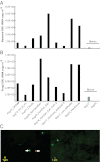Microbiome of the upper troposphere: species composition and prevalence, effects of tropical storms, and atmospheric implications
- PMID: 23359712
- PMCID: PMC3574924
- DOI: 10.1073/pnas.1212089110
Microbiome of the upper troposphere: species composition and prevalence, effects of tropical storms, and atmospheric implications
Abstract
The composition and prevalence of microorganisms in the middle-to-upper troposphere (8-15 km altitude) and their role in aerosol-cloud-precipitation interactions represent important, unresolved questions for biological and atmospheric science. In particular, airborne microorganisms above the oceans remain essentially uncharacterized, as most work to date is restricted to samples taken near the Earth's surface. Here we report on the microbiome of low- and high-altitude air masses sampled onboard the National Aeronautics and Space Administration DC-8 platform during the 2010 Genesis and Rapid Intensification Processes campaign in the Caribbean Sea. The samples were collected in cloudy and cloud-free air masses before, during, and after two major tropical hurricanes, Earl and Karl. Quantitative PCR and microscopy revealed that viable bacterial cells represented on average around 20% of the total particles in the 0.25- to 1-μm diameter range and were at least an order of magnitude more abundant than fungal cells, suggesting that bacteria represent an important and underestimated fraction of micrometer-sized atmospheric aerosols. The samples from the two hurricanes were characterized by significantly different bacterial communities, revealing that hurricanes aerosolize a large amount of new cells. Nonetheless, 17 bacterial taxa, including taxa that are known to use C1-C4 carbon compounds present in the atmosphere, were found in all samples, indicating that these organisms possess traits that allow survival in the troposphere. The findings presented here suggest that the microbiome is a dynamic and underappreciated aspect of the upper troposphere with potentially important impacts on the hydrological cycle, clouds, and climate.
Conflict of interest statement
The authors declare no conflict of interest.
Figures



Comment in
-
Environmental microbiology: plant bacteria thrive in storm clouds.Nat Rev Microbiol. 2013 Mar;11(3):146. doi: 10.1038/nrmicro2978. Nat Rev Microbiol. 2013. PMID: 23411853 No abstract available.
-
Inadequate methods and questionable conclusions in atmospheric life study.Proc Natl Acad Sci U S A. 2013 Jun 4;110(23):E2084. doi: 10.1073/pnas.1302612110. Epub 2013 Apr 30. Proc Natl Acad Sci U S A. 2013. PMID: 23633574 Free PMC article. No abstract available.
-
Reply to Smith and Griffin: Methods, air flows, and conclusions are robust in the DeLeon-Rodriguez et al. study.Proc Natl Acad Sci U S A. 2013 Jun 4;110(23):E2085. doi: 10.1073/pnas.1304466110. Proc Natl Acad Sci U S A. 2013. PMID: 23882709 Free PMC article. No abstract available.
References
-
- Despres VR, et al. Primary biological aerosol particles in the atmosphere: A review. Tellus B Chem Phys Meterol. 2012;64 10.3402/tellusb.v64i0.15598.
-
- Möhler O, DeMott PJ, Vali G, Levin Z. Microbiology and atmospheric processes: The role of biological particles in cloud physics. Biogeosciences. 2007;4(6):1059–1071.
-
- Vali G, et al. Biogenic ice nuclei. Part II: Bacterial sources. J Atmos Sci. 1976;33(8):1565–1570.
-
- Bauer H, et al. Airborne bacteria as cloud condensation nuclei. J Geophys Res. 2003;108(D21):4658.
-
- Amato P. Clouds provide atmospheric oases for microbes. Microbe. 2012;7(3):119–123.
Publication types
MeSH terms
LinkOut - more resources
Full Text Sources
Other Literature Sources
Medical
Miscellaneous

